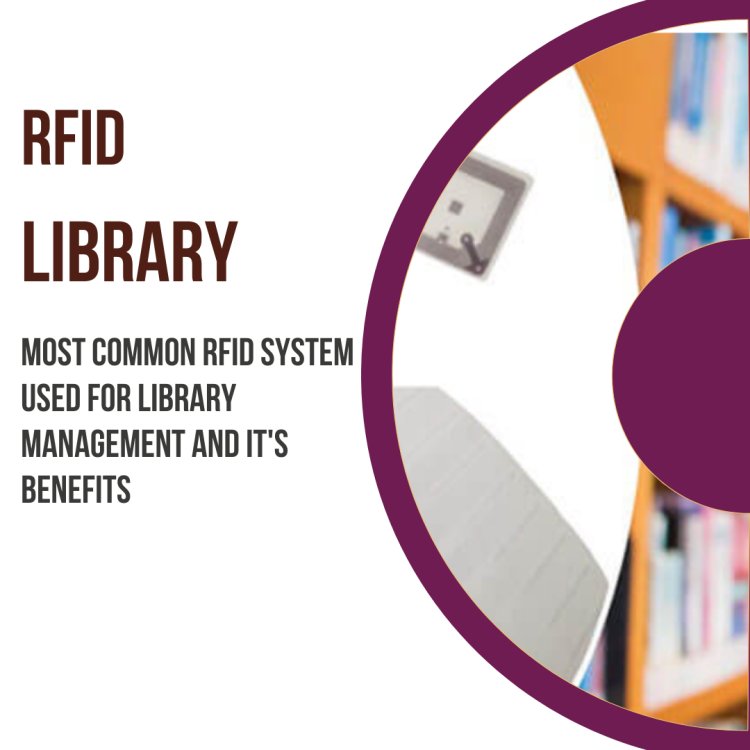Most common RFID System Used for Library Management and It's Benefits
Explore the world of RFID systems transforming library management to learn about the most common system by navigating through the diversity of RFID solutions, with a focus on the cost-effective and secure nature of passive RFID systems
Share this Post to earn Money ( Upto ₹100 per 1000 Views )

Explore the world of RFID systems transforming library management to learn about the most common system by navigating through the diversity of RFID solutions, with a focus on the cost-effective and secure nature of passive RFID systems
In the ever-evolving landscape of library management, the adoption of Radio-Frequency Identification (RFID) technology has surged, fueled by its seamless blend of ease, efficiency, and effectiveness. As libraries worldwide seek innovative solutions to streamline operations, RFID emerges as a solution of transformative potential.
However, choosing the suitable RFID systems available can be confusing, given the diversity in frequencies, read ranges, and speeds. The quest for the most suitable RFID solution becomes a challenging journey, with choices tailored to specific library requirements.
Amid this diversity, passive RFID systems stand out as the cornerstone of library management. Despite operating within a maximum frequency range of 135KHz – comparatively lower than their high and ultra-high frequency counterparts – passive RFID solutions have become the go-to choice for libraries globally.
Now, let's embark on a journey to reveal the manifold benefits that accompany the integration of passive RFID systems in library management, shedding light on how this technology redefines the way libraries organize, track, and enhance user experiences.
Cost Effectiveness
Implementing RFID technology in libraries presents a significant challenge, primarily centered around the initial installation costs and the ongoing maintenance required for sustained system performance.
Despite this hurdle, the adoption of passive RFID systems, encompassing cost-effective components like RFID tags and readers, emerges as a pragmatic solution. These components, while less expensive, prove efficient for library management.
The cost-effectiveness is further amplified by the flexibility to choose different types of tags based on the diverse materials within the library resources. This approach not only minimizes the overall budget needed for embracing the new technology but also positions passive RFID systems as a financially viable and efficient choice for revolutionizing library operations in the long run.
Security is Not a Concern
The adoption of RFID library systems, particularly embracing passive solutions operating at low frequency and wavelength, introduces a layer of enhanced security to the management of valuable resources.
The deliberate design of a shorter read range in these systems acts as a safeguard, minimizing the risk of unauthorized access and data retrieval from the chips affixed to critical resources. This proactive security measure not only reduces the chances of data and resource theft but also fortifies the integrity of the library's holdings.
Moreover, the intentional interference created when attempting to read multiple tags simultaneously without proper settings serves as an additional deterrent, ensuring that the library staff is promptly alerted to any potential unauthorized activities, thus maintaining a robust security infrastructure.
More Life of the Tags
The utilization of passive RFID tags in library management brings forth a remarkable advantage—the absence of an internal power source. This inherent feature eliminates the need for an external power supply to activate the chips during information processing, resulting in minimal wear and tear.
In the face of environmental changes and electromagnetic waves encountered during routine audits, passive RFID tags prove resilient and enduring. Unlike the active and semi-active chips, these tags posses an impressive lifespan of over 20 years, lessening the need for frequent tag.
This not only streamlines operational efforts but also significantly reduces the associated expenses, offering libraries a cost-effective and durable solution for efficient long-term management.
Easy to Reuse
A standout feature of Passive RFID tags in library management lies in their exceptional reusability. With available storage and writing cycles, these tags can be seamlessly repurposed, allowing for efficient resource allocation within the library.
This flexibility enables the effortless replacement of tags from one resource to another, aligning with evolving library needs and current requirements. The capacity for reuse not only optimizes the utilization of RFID technology but also reflects a sustainable approach, minimizing the efforts required for tag management and ensuring that libraries can adapt and customize their organizational systems with ease.
Conclusion:
In conclusion, the integration of RFID technology, particularly passive systems, is revolutionizing library management by offering a pragmatic solution to streamline operations. Despite initial installation challenges and ongoing maintenance concerns, the cost-effectiveness of passive RFID components positions them as a financially viable and efficient choice for libraries globally. Moreover, the impressive lifespan of over 20 years for passive RFID tags, coupled with their ease of reuse, minimizes operational efforts and associated expenses. In essence, passive RFID systems emerge as a transformative force, reshaping the landscape of library management and ensuring a seamless user experience.
















